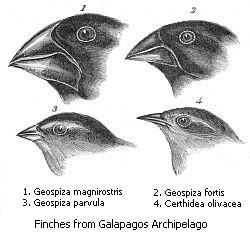
| Part of a series on |
| Evolutionary biology |
|---|
 |
In evolutionary biology, adaptive radiation is a process in which organisms diversify rapidly from an ancestral species into a multitude of new forms, particularly when a change in the environment makes new resources available, alters biotic interactions or opens new environmental niches.[1][2] Starting with a single ancestor, this process results in the speciation and phenotypic adaptation of an array of species exhibiting different morphological and physiological traits. The prototypical example of adaptive radiation is finch speciation on the Galapagos ("Darwin's finches"), but examples are known from around the world.
- ^ Cite error: The named reference
Larsenwas invoked but never defined (see the help page). - ^ Schluter, Dolph (2000). The Ecology of Adaptive Radiation. Oxford University Press. pp. 10–11. ISBN 0-19-850523-X.